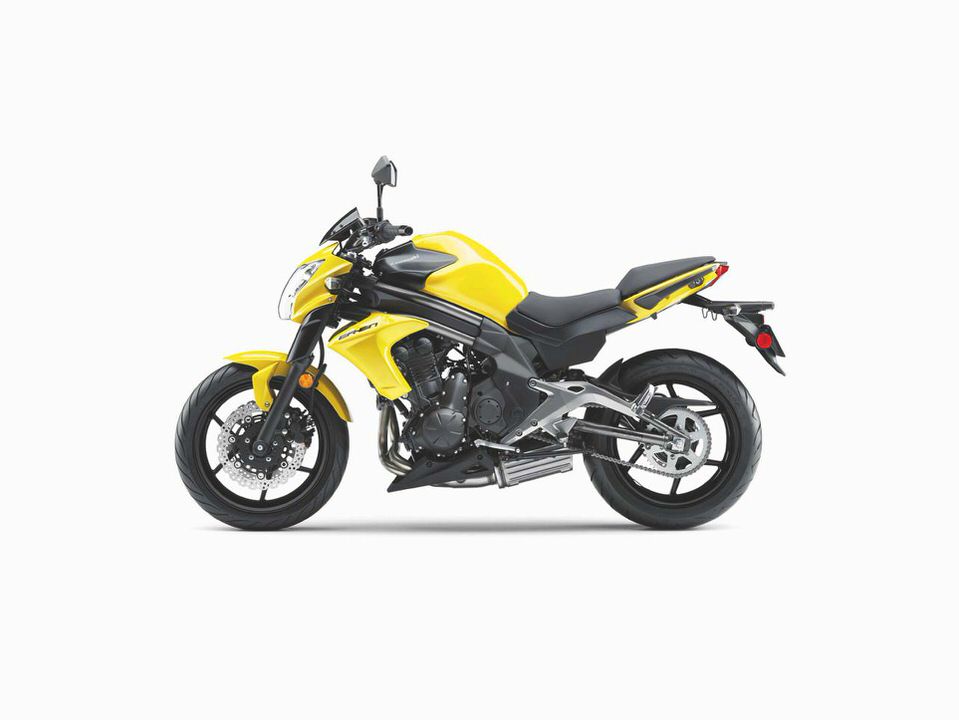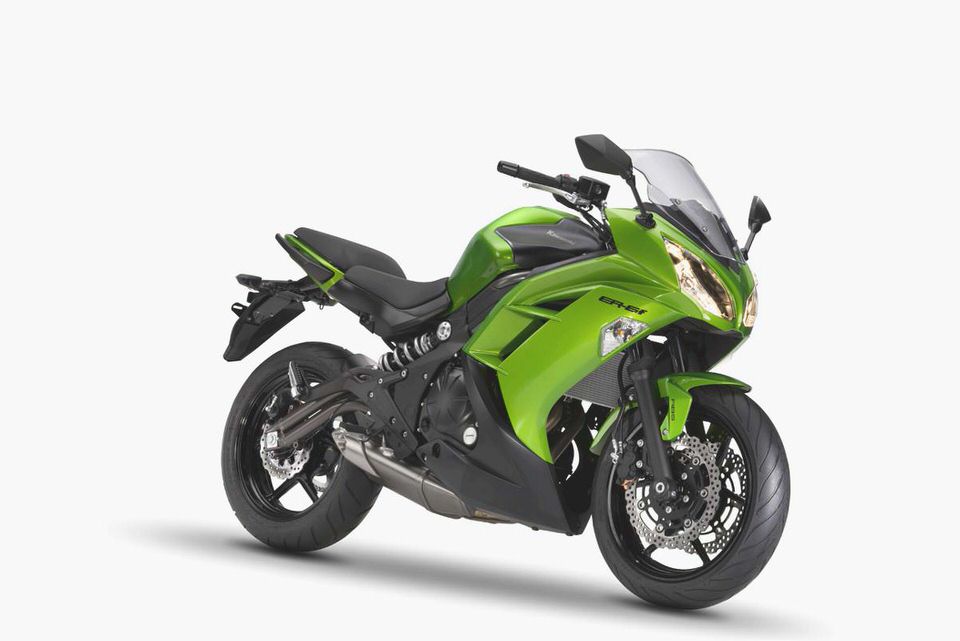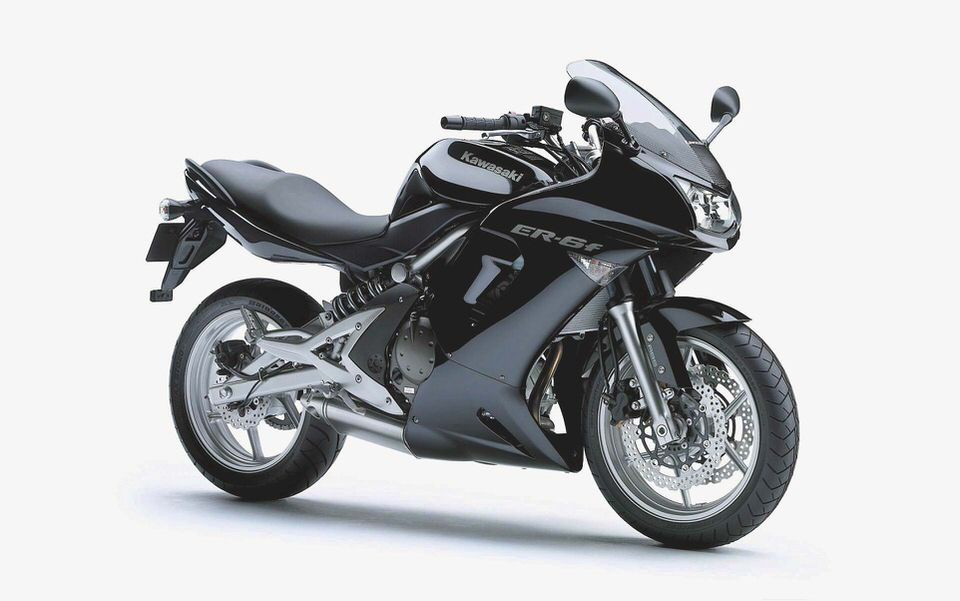
2011 Kawasaki Ninja 1000: MD First Ride
The concept seems simple enough. Take top shelf components designed for a pure sport bike, including adjustable suspension, radial-mounted disk brakes, aluminum twin-spar chassis, and a take–no–prisoners motor and combine these elements with real-world, comfortable ergonomics for the street. Simple, but surprisingly rare among production motorcycles.
Kawasaki cannot claim to be the first to do this, as Aprilia and Ducati certainly have followed this formula in the past, but among the Japanese manufacturers the new Ninja 1000 is something special.
The Ninja 1000 shares an awful lot with its naked sister, the Z1000, but this is not a bad thing. We praised the Z1000. as did virtually every other journalist. The suspension, brakes and engine on this bike put a Japanese naked on the same playing level as the pricier European exotics mentioned above.
Moreover, the Z1000 and the Ninja 1000 were developed simultaneously. The Ninja 1000 is not a Z1000 with bodywork slapped on it as an afterthought. This machine was designed from the beginning to serve two purposes, both naked and clothed.
Before we get into our riding impression of the Ninja 1000, courtesy of a romp through the beautiful hills of Marin County, California earlier this week, let’s talk about the essence of this motorcycle, particularly, its engine.
The thoroughly modern 1043cc four-cylinder powerplant is fed by fuel injection and produces awesome power for the street. This is not a de–tuned sport bike engine, it is an engine purpose built to provide more usable street power to the rider than either 1000cc sport bikes or 600cc sport bikes. That’s right, nine times out of ten, this bike is faster on the street than the latest 1000cc superbikes.
Most of those superbikes will do 100mph, or more, in first gear, meaning peak horsepower from those engines probably arrives beyond legal speeds in first gear. Will you use that peak horsepower on the street? Generally no, with rare exceptions.
Take a look at this comparison between Kawasaki’s own sport bikes with the Ninja 1000. As our riding confirmed, the Ninja 1000 has power virtually everywhere you will use it on the street… no waiting.
What about peak power? According to Kawasaki, the Ninja 1000 delivers 10% more peak horsepower than the ZX-6R, and 65% more torque. At the same time, although the Ninja 1000 is down on the high RPM horsepower provided by the ZX-10R, it produces the same peak torque at lower RPM.
The adjustable suspension components are slightly smoother and softer than sport bike units, providing a better ride on the street, but still allowing the rider to stiffen up the units for a track day. The 300 mm front disc brakes get radial-mount brake calipers and a radial-pump master cylinder, state-of-the-art for the sport bike class.
Nothing on this bike looks cheap or acts cheap. The swingarm is where many manufacturers save money on a naked, but the Ninja 1000 gets an aluminum swingarm with a built-in eccentric chain adjuster. Unlike a naked, of course, the Ninja 1000 offers excellent wind protection along with a full fairing reminiscent of a sport bike.
That fairing includes a distinctive slat in front of the engine that helps direct hot air away from the rider. During our testing, we did not notice any significant heat coming from the engine, but the weather was cool and hot weather testing would be warranted.
That bodywork and simple, three-position windscreen, provide surprising wind protection, without buffeting. The windscreen assumes one of three positions simply by pushing a button in front of the instrument panel and manually selecting the position desired. No tools and no waiting.
You can easily change the position of the windscreen at a stoplight, if you desire.
Along with the frame and suspension elements derived from the world of sport bikes, you get light-weight wheels and sport bike instrumentation. The instruments are taken from the ZX-6R, with different fonts and colors. Included is a very legible, traditional analog tachometer next to an LCD screen that includes a speedometer, fuel gauge, clock, dual trip meters and assorted warning lamps.
The fuel gauge is easily read at a glance, it is appreciated when combined with the comfort and long-distance touring capabilities of this bike.
The riding position is just about perfect for this 5’10″ test pilot. The bars are higher and closer than many found on sport tourers. The seat is thicker and more comfortable than that typically found on a sport bike.
The pegs are a bit high compared to many sport tourers, but still much lower than those found on a pure sport bike.
Those pegs deserve special comment. It is always interesting to note whether a manufacturer paid attention to the important details. Here, along with the smooth engine, Kawasaki took great pains to eliminate any unwanted vibration traveling through the footpegs to the rider’s feet. Both the front and rear pegs are rubber-coated, but the front pegs are also rubber mounted and feature a counterbalancing weight on the heel guard to further reduce vibration.
The result is an extremely smooth riding experience that was even a bit surprising when we first pulled out of the parking lot for our test.
Kawasaki even made the passenger seat thicker, longer and wider than those typically found on a sport bike, so that a passenger can experience something short of the torture-rack found at the back of most super sports.
Although the engine is virtually the same as that found in the Z1000, rated at 138 PS at the crank, it has slightly taller final gearing (41 tooth rear sprocket versus 42 on the Z1000). This change reflects the distinct likelihood that the Ninja 1000 will be used for highway touring, but it is not enough of a difference to blunt the stupendous acceleration offered by the bike.
As you might expect, Kawasaki is working on plenty of accessories for this bike. We saw a Ninja 1000 with saddlebags attached, but those are not yet available. Kawasaki promised they would be available soon, however, and you can expect pricing to be similar to the pricing of this accessory on the Versys, since they are the same bags.
Different windshields, heated grips and a trunk are also under development.
What is it like to ride the Ninja 1000? Not surprisingly, it is similar to riding a Z1000, with the added comfort provided by the windscreen and fairing protection. The bars are in a similar position, but are actually angled a bit more towards the rider.
The result is a seating position that was hard to criticize. Sporty enough, but offering comfort worlds beyond a super sport. Most of the time, we ran the windscreen in the middle position.

The stock photos you see typically have the screen in its lowest position, but we found the middle position to provide excellent upper body wind protection without buffeting at the helmet level.
Wind protection for the lower body was also excellent. Combined with the low vibration levels, this bike could easily be toured on, and Kawasaki knows it. Our only criticism would be the fact that the seat seems to push the rider forward onto the tank more than it should.
As we have previously reported in the Z1000 test, engine performance is outstanding. The fuel injection is very well dialed in, and transitions from closed to open throttle are quite smooth. The bike will pull from under 3000 RPM smoothly, and provide decent forward thrust above 4000 RPM.
Corner exits above 5000 RPM are plenty strong, allowing the rider to roll the throttle on as he stands the bike up, and then feel a bit of a power bump at 7000 RPM as the Ninja 1000 squirts towards the next corner.
The handling of the Ninja 1000 was, perhaps, the most surprising thing about our test. The upright ergonomics and relatively wide bars, coupled with the relatively light weight, and well centralized mass (which the horizontally-mounted shock absorber contributes to), results in a machine that changes directions almost effortlessly relative to other open-class bikes. This nimble nature is coupled with excellent stability and confidence from the front end.
Although the front wheel can get light on corner exits, and we sometimes found ourselves slightly crossed-up when hard on the gas. we never experienced anything remotely resembling head shake, and really learned to trust the front end of this bike.
The transmission performed its duties without complaint, and without requiring much attention from the rider. The brakes are strong and progressive, although we could have used a bit more feel from the powerful front binders. Our test bike came with excellent Bridgestone sport bike rubber.
The Ninja 1000 is an excellent motorcycle. After just one day of testing, coupled with our knowledge of the Z1000 from earlier tests, we can confidently say the Ninja 1000 is an outstanding motorcycle, and one of the most versatile motorcycles we have ever ridden. There is very little compromise in this machine.
Can it run with sport bikes in the twisties? No question about it, and it will exit corners harder than most sport bikes without paying too much attention to where the tachometer is pointing when you pull the trigger. Does it work droning along in a straight line on the super slabs? Absolutely, and rider fatigue won’t be much different than the fatigue experienced on a modern sport tourer.
Touring, commuting, play riding on the weekends. the Ninja 1000 can clearly do all of these things, and do them quite well. The 5 gallon fuel tank (1 more gallon than the Z1000) should provide plenty of range (although we didn’t take fuel consumption figures at the press launch, we traveled over 120 hard riding miles without refueling, and the bike seemed to have a fair amount of gas left).
Will the Ninja 1000 sell well in the United States? That is hard to predict, but American attitudes certainly work against it. Younger riders want pure sport bikes, regardless of the fact that these bikes are generally slower on the street.
These riders won’t think about the fact that they can’t live above 10,000 RPM on public highways. Nevertheless, there seems to be emerging a more mature, thoughtful American consumer for motorcycles. This could be the Ninja 1000′s saving grace.
These consumers will get an extraordinarily versatile motorcycle. They will get a motorcycle at a price significantly below the price of the latest-and-greatest, open-class superbike, while benefiting from many of the same top shelf components and performance capabilities. Oh yeah, and they might also save some money on chiropractor visits and Advil purchases.
The Ninja 1000 will be in U.S. dealer showrooms in the two colors pictured shortly after you read this at an MSRP of $10,999. Visit Kawasaki’s web site for additional details.
Motorcycle Daily attended a manufacturer-sponsored event, to which selected members of the press were invited, to facilitate this report.


- Kawasaki ER6f 2012: first road?
- 2012 Kawasaki Vulcan 900 Classic LT – Used 2012 Vulcan 900 Classic LT…
- KAWASAKI NINJA 650R – Reviews Price Specifications Mileage Ratings…
- Kawasaki Vulcan 1700 Vaquero 2013 Review – Specs And Picture Top Motorcycles…
- The Specifications for a 1985 Kawasaki ZL900 Eliminator eHow

